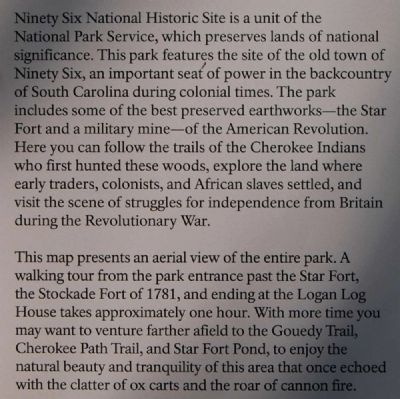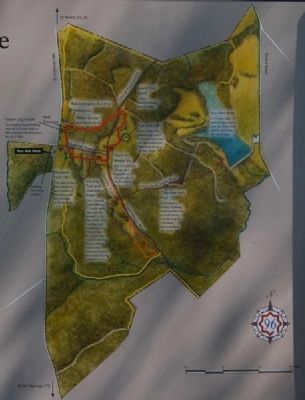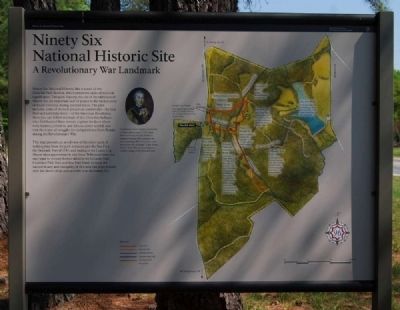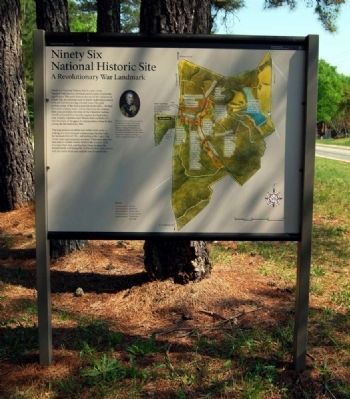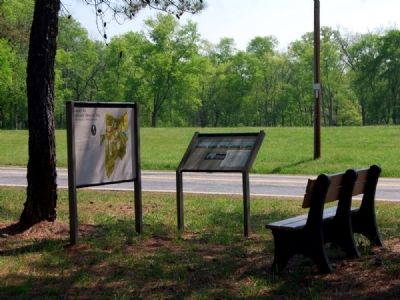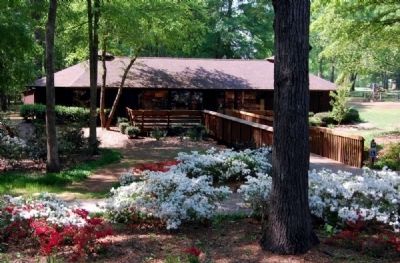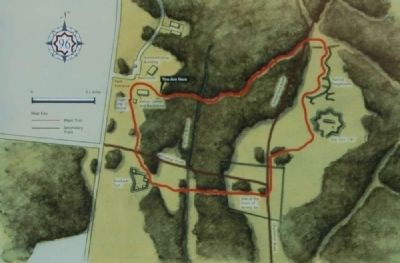Ninety Six in Greenwood County, South Carolina — The American South (South Atlantic)
Ninety Six National Historic Site
A Revolutionary War Landmark
Ninety Six National Historic Site is a unit of the National Park Service, which preserves lands of national significance. This park features the site of the old town of Ninety Six, an important seat of power in the backcountry of South Carolina during colonial times. The park includes some of the best preserved earthworks -- the Star Fort and a military mine -- of the American Revolution. Here you can follow the trails of the Cherokee Indians who first hunted these woods, explore the land where early traders, colonists, and African slaces settled, and visit the scene of struggles for independence from Britain during the Revolutionary War.
This map present an aerial view of the entire park. A walking tour from the park entrance past the Star Fort, the Stockade Fort of 1781, and ending at the Logan Log House takes approximately one hour. With more time you may want to venture farther afield to the Gouedy Trail, Cherokee Path Trail, and Star Fort Pond, to enjoy the natural beauty and tranquility of this area that once echoed with the clatter of ox carts and the roar of cannon fire.
Erected 2009 by National Park Service.
Topics. This historical marker is listed in these topic lists: Colonial Era • Forts and Castles • Settlements & Settlers • War, US Revolutionary. A significant historical year for this entry is 1781.
Location. 34° 8.683′ N, 82° 1.478′ W. Marker is in Ninety Six, South Carolina, in Greenwood County. Marker is at the intersection of South Cambridge Road (State Highway 248) and County Route 225, on the right when traveling south on South Cambridge Road. Touch for map. Marker is in this post office area: Ninety Six SC 29666, United States of America. Touch for directions.
Other nearby markers. At least 10 other markers are within walking distance of this marker. The Lost Town of Cambridge (here, next to this marker); Ninety Six National Historic Site / Greenwood County (a few steps from this marker); First Blood Shed for Liberty (within shouting distance of this marker); The Stockade Fort (about 400 feet away, measured in a direct line); Militiamen (about 500 feet away); "Light Horse Harry" Lee Takes the Stockade Fort (about 500 feet away); Sharpshooter (about 500 feet away); Monument to James Birmingham (about 600 feet away); James Birmingham (about 600 feet away); Logan Log House (about 700 feet away). Touch for a list and map of all markers in Ninety Six.
Also see . . .
1. Ninety Six National Historic Site (U.S. National Park Service). Here settlers struggled against the harsh backcountry
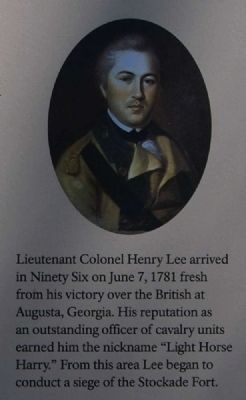
Photographed By Brian Scott, April 16, 2010
2. Ninety Six National Historic Site Marker -
Lieut. Col. Henry Lee
Lieut. Col. Henry Lee
Lieutenant Colonel Henry Lee arrived in Ninety Six on June 7, 1781 fresh from his victory over the British at Augusta, Georgia. His reputation as an outstanding officer of cavalry units earned him the nickname "Light Horse Harry." From this area Lee began to conduct a siege of the Stockade Fort.
2. Ninety Six National Historic Site. The historic district of Ninety Six National Historic Site contains numerous historical features associated with the economic and social development of the colonial South Carolina back country. (Submitted on May 10, 2010, by Brian Scott of Anderson, South Carolina.)
3. Ninety Six National Historic Site. Ninety Six National Historic Site, also known as Old Ninety Six and Star Fort, is a United States National Historic Site located about 60 miles (96 kilometers) south of Greenville, South Carolina. (Submitted on May 10, 2010, by Brian Scott of Anderson, South Carolina.)
4. National Park Service. The National Park Service (NPS) is the U.S. federal agency that manages all national parks, many national monuments, and other conservation and historical properties with various title designations. (Submitted on May 10, 2010, by Brian Scott of Anderson, South Carolina.)
5. Henry Lee III. Henry Lee III (29 January 1756 – 25 March 1818) was an early American patriot who served as the ninth Governor of Virginia and as the Virginia Representative to the United States Congress. (Submitted on May 10, 2010, by Brian Scott of Anderson, South Carolina.)
Additional commentary.
1. Ninety Six Historic Site
In Greenwood County is the site of the once-flourishing Colonial village of Ninety Six, renamed Cambridge after the Revolution. Even before 1730, the fork lying 96 miles south of the Cherokee Indian town of Keowee was an important post and of Indian and Revolutionary War fortifications, Ninety Six was also a busy courthouse town, its gaol and courthouse described as brick buildings. It has also been described as a "snug little village of 15 or 20 houses and stores." As many as 17 stores were noted at one point...and the population included "4 merchants, as many lawyers, hotel keepers, tailor, blacksmith, carriage and harness shops, and three physicians...there was also belonging to the place a large and well-selected library, and a flourishing academy...there was a church there..."
In the early 1750s, Indian trader Robert Gouedy settled at Ninety Six, his land grant lying astride the Cherokee Path, which later ran through the center of town. Gouedy's store was supposedly the largest house the fall line. Extant from this period is the grave of Gouedy's son, James, in a wooded area south of Star Fort and perhaps near the site of the original Gouedy homeplace.
Gov. William Henry Lyttleton's 1759 expedition built a fort around Gouedy's barn, and this stockade, described as 90' square, provided protection of settlers from a wide surrounding area.
First of the town's Revolutionary fortifications was built in November 1775 at Colonel Savage's plantation, of Savage's Old Field. Separated from Ninety Six courthouse and gaol by a ravine and spring, this was a "temporary stockade fort of fence rails, straws, beeves' hides and other such materials...a square of about 185 yards...the curtains of defense extended from a barn and store to some outhouses; and at a distance of 250 yards from the gaol."
When the British occupied Ninety Six in 1780, they added fortifications to the existing stockade. Major defensive features was a redoubt on the southeast tip of the village. There was Star Fort and it was surrounded by a ditch. Three cannon on wheels strengthened by a stockade, and the gaol was fortified. Further strengthening was added by an embankment of earth surrounding the village and by abatis, a type of defense using felled trees with the branched ends stocking outward. Within the village, blockhouses were erected and covered ways built for safe communication. On the north side of the village a small stream supplied the garrison with water. A stockade fort with two blockhouses was built to defend the stream on the side opposite the village palisade. A covered way led to the stream between these two strong points. Added to the military engineering of the British was that of the besieging American forces: three parallels, two trenches, a mine reaching almost to the Star Fort ditch, two log towers for firing into the fort.
The 1964 National Survey of Historic Sites and Buildings (Colonials and Patriots) describes Star Fort as "an earthwork with eight salients and eight reentrant angles, enclosing about one-half acre northeast of the village."
This same authority reports that "the Star Fort outlines are still readily discernible as earthwork embankments 4 or 5 feet high. Scattered brick fragments mark the location of the town, which was burned by the British, later rebuilt but lost its court in 1800 and declined in importance. Some identifiable remains include the knoll on which the 1775 siege occurred and on which stood the British stockade fort of 1781, the raving in which flowed the stream supplying water to the garrison, the jail site, the old Charleston Road, and some distance from the village site, the 1759 fortification.
Significance
One of the oldest English place names in upper South Carolina, one that is significant in South Carolina history and that had a bearing on U.S. history, Ninety Six was of prime importance in upcountry development of the state. Its early history reflects the activity, color, and romance of the typical frontier community of the Colonial era.
The importance of Ninety Six has three distinct phases:
(1) As a trading and meeting junction in colonial years, reflecting South Carolina's Indian and frontier period. On George Hunter's 1730 map of South Carolina's northwest frontier, "96" appears as a special designation on the Cherokee Path, well-traveled pack trail to and from Charleston before 1700. (The original of this map is in the Library of Congress.) Its importance as a trading post is indicated in the 1738 Journal of the House of Assembly. And Gov. James Glen recognized its strategic location be choosing it for his 1746 Indian conference. (This colorful meeting was attended by the S.C. emperor of the Cherokees and 60 of his headmen; accompanying the governor were 4 companies of troops and 200 additional gentlemen.)
(2) As the northwestern area's farthest English settlement from the coast, a thriving Colonial village from as early as 1740 and a busy courthouse town for huge Ninety Six District from 1768 until shortly after 1800. After the 1768 Commons House of Assembly Bill establishing courts, building jails, appointing sheriffs, etc., the development
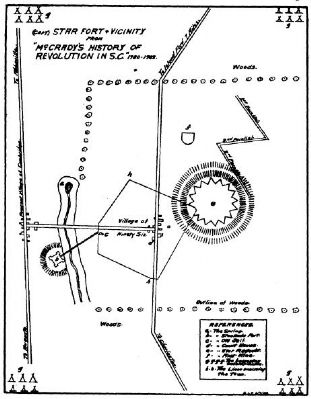
Photographed By National Register Nomination Form
7. Ninety Six and Star Fort
This sketch of ninety Six and Star Fort was published in 1822 in Johnson's Life of Nathanael Green and has since been copied in several publications. Roberts said the design resembled a child's drawing of a seated cat, with the fort as the hear, the village as the body, and the covered passage to the small stockade as the tail.
During the Colonial period, Ninety Six was a key location in a number of historic expeditions:
(a) Col. George Chicken's 1715 journey inland during the Yemassee War, his journal possible representing the first English account of a Carolina back country traveler and including the only mention of buffalo hereabouts ("we kill'd a boflow this day").
(b) Gov. Glen's 1746 expedition to confer with the Cherokee.
(c) Gov. Lyttleton's 1759 expedition which built, en route, a stockade at Ninety Six that protected area settlers during the 1759-61 Cherokee War. (In March 1760, the garrison withstood a 36-hour Cherokee attack.) Ninety Six also served as a supply center and base of operations for ranger and militia companies and from this time until the Revolution had numerous links with Fort Charlotte, built 1766 on the Savannah River.
(d) The 1775 mission to the back country by William Henry Drayton and the Rev. William Tennett, sent from Charleston by the Council of Safety to explain the American-British disputes and to enlist patriot aid.
(3) As a Revolutionary War stronghold and also as a focal point of violent Patriot-Tory strife. Pre-Revolutionary activity included the raising of a Ranger troop in the Ninety Six area (June 1775) which made the first overt act of the Revolution in South Carolina -- the July 1775 seizure of Fort Charlotte from the British. Ranger commander was James Mayson, who lived near Ninety Six village. In August 1775, Ninety Six sent nine representatives to the Second Provincial Congress. One of these as Commander Mayson.
The Revolution's first land battle south of New England took place at Ninety Six, Nov. 19-12, 1775. Patriot forces, besieged inconclusively, finally defeated and dispersed the Tories in December. In this battle, James Birmingham was the first South Carolina Patriot to give up his life in the Revolution. Andrew Pickens, who later became one of South Carolina's three famous partisan generals, was a company commander in this action.
Old Ninety Six reached the peak of its fame in 1780-81 when it was a British garrison an scene of the siege of Star Fort, one of the most interesting and spectacular operations of the revolutionary's closing months.
In 1779, the British returned to their earlier plan of trying to roll up the states from south to north, and after the 1780 capture of Charleston, ordered three expeditions to the interior to gain control of the state. Ninety Six became important as the most advanced British post, supporting the other two posts, at Augusta and Camden, also covering loyalist settlements and serving as a recruiting depot for Tory fighters.
The Star Fort, built at this time, continued as a British outpost, manned by regulars and Tories, until May-June 1781, when Gen. Nathanael Greene's American force invested and assaulted the fort. The siege was unsuccessful since the fort's star form gave the enemy complete command and exposed the attackers to close cross-fire. Advancing British reinforcements spurred American withdrawal. The British, however, evacuated the fort at the end of the 27-day siege. This relinquishment of the inland South Carolina foothold helped weaken the south-to-north British offensive and was a contributing factor to the war's outcome.
Associated with Old Ninety Six are such historically significant names as Patrick Calhoun (father of John C.), Andrew Pickens, and Sen. John Gervais, who was instrumental in changing the state capital from Charleston.
In post-Revolutionary years, Ninety Six achieved some importance as a college town. Site of one of three colleges authorized by the S.C. General assembly in March 1785, the town changed its name to Cambridge in 1787 in honor of the college. The institution enjoyed no lasting success, however, and by the mid 1820s, the once-flourishing town had almost ceased to exist. (Source: National Register nomination form.)
— Submitted May 10, 2010, by Brian Scott of Anderson, South Carolina.
Credits. This page was last revised on December 13, 2019. It was originally submitted on May 10, 2010, by Brian Scott of Anderson, South Carolina. This page has been viewed 1,280 times since then and 14 times this year. Photos: 1, 2, 3, 4, 5, 6. submitted on May 10, 2010, by Brian Scott of Anderson, South Carolina. 7. submitted on May 9, 2010, by Brian Scott of Anderson, South Carolina. 8, 9. submitted on May 14, 2010, by Brian Scott of Anderson, South Carolina.
